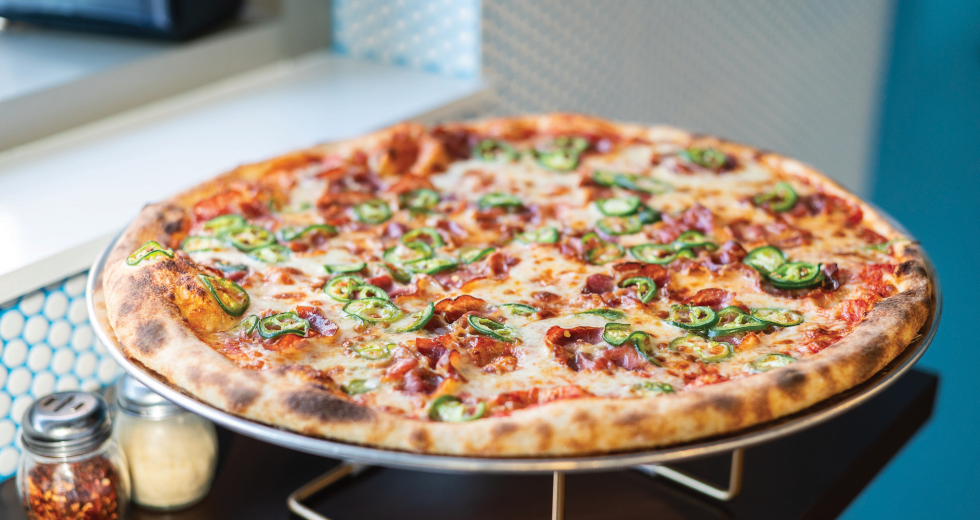Your experience of social media may be as a fun time-waster, an angst-producing FOMO (fear of missing out) machine or the reason you know your Uncle Dennis believes in ancient aliens. But to many restaurant owners, social media is a necessity.
Ben Roberts, owner of Pizza Supreme Being in Sacramento, has 13,500 followers on Instagram, but he has no love for social media. “It’s one of the things you have to do now, because everyone wakes up and looks at their phones, everyone at lunch looks at their phones,” he says semi-wearily. “They lie in bed looking at their phones.”
Roberts does all the photography and editing himself (having honed those skills filming skate videos since he was in seventh grade), with caption-writing help from his copywriter wife Pembe Sonmez-Roberts — or increasingly, now that she’s busy raising their young child, Chat GPT.
He feels obligated to post once a day when they are open. “I struggle with creativity block. Like, what am I going to post today? I can only take photos of three pizzas so much.”
His Instagram presence is cheeky and inflected with the visual signifiers of streetwear and punk; ranch dressing-based humor is frequent. His most-viewed Reel on Instagram is a clip of him pouring a giant Nalgene tub of ranch while “The Star-Spangled Banner” plays in the background. Another popular one is a cinematic tear-jerker of Roberts in a lonely kitchen, tenderly rolling balls of dough, with a voiceover of his grandfather praising his work ethic, cut with quick shots of him turning the lights on in the new space PSB expanded to last year (formerly Zia’s Deli).
As for buzzy TikTok, he feels that, lacking dance ability, his best use of it is to be able to add more selections of copyrighted music to videos (an option that Instagram is more stringent about blocking) to repost on Instagram Reels. But he points out that his special at the time of the interview, a chopped Italian sub (a pile of chopped veg and meat, including crispy pepperoni bits, glossed with Kewpie-brand mayonnaise), is copied from a TikTok trend.
Posts for hire
Matt Chong, founder and operator of Disrupt Marketing, who handles the social media of several prominent restaurants, including Bill Ngo’s Kru and Kodaiko Ramen and Bar, Camellia Coffee Roasters and up-and-comer Southside Super, spends a lot of time thinking about aesthetics. “Each of the accounts definitely has almost a kind of a different character,” he says.
He ticks down the list: Southside Super is “kind of like Wes Anderson, honestly,” he says, referring to the filmmaker best known for stylish romps like “Grand Budapest Hotel” and “Moonrise Kingdom”; “the color tones, the palette, the symmetry.” Camellia is “supposed to feel like I’m walking into my favorite skateboard shop or comic book store … funky and eclectic.” Kru is “sexy, refined, minimal.”
Matt Chong, founder and operator of Disrupt Marketing, handles
the social media for Camellia Coffee Roasters and other prominent
Sacramento brands.
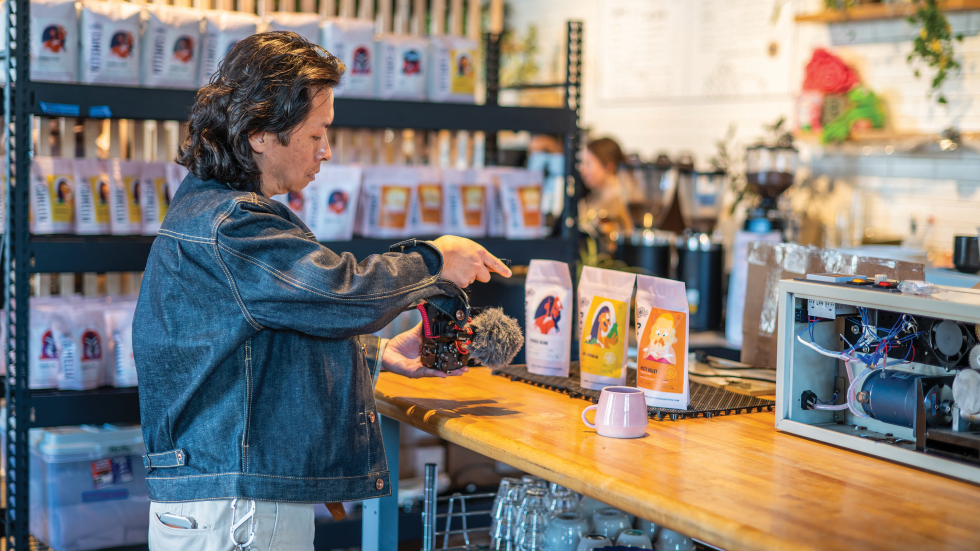
Chong founded Disrupt Marketing with business partner Soreath Hok, who has since taken a step back, in early 2016. It brought together his experience in a multitude of different fields: marketing for communications companies, writing and editing for now-defunct Hits Magazine, running Infusion Café on K Street from 2003-2005, and in 2011, partnering with the recently passed Chef Chris Jarosz on ventures including food truck Wicked ‘Wich, two Broderick Roadhouses and now Michelin-starred Localis. He founded Disrupt after he left that partnership.
It made sense that he would handle the social media (mostly Facebook at the time) for those businesses, which led to inquiries from others. “I started getting calls from other peers in my industry asking, ‘Hey, can you do social for us?’ Because social was definitely the catalyst for growth at Broderick.” Ngo’s poke spot Fish Face was an early client, followed by Camellia Coffee. Kru followed soon after.
He mostly gains clients from word of mouth and makes no promises about metrics. “Engagement within an app does not translate into butts in seats or higher ticket average,” he says. “I never really want to make that promise. I just want people to understand that I understand their business model, and the idea is to take what they’re doing really well and turn up the volume.” Promises aside, his posts have enough clout that sometimes he’ll be asked to not post a particular dish on a busy day because the rush to order it could cause a catastrophic kitchen backup.
From the beginning, Anthony Bourdain and his show “No Reservations” inspired Chong to focus his camera on the back of the house, a practice that he continues to this day. “Our line cooks and, you know, guys in the dish pit; I found that people really related to it,” he says.
Chong feels a “pretty drastic” style change coming due to the oversaturation and desensitization that comes from heavy use of social media. “There’s just too much repetitive content,” he says. “People can’t copy culture and personality, so I’m trying to figure out ways to pivot it.” These ways include less frequent posting and short films that bring out that ineffable culture, like one of the Southside Super staff naming their favorite local restaurants that has almost 10,000 views. A video explainer for how to order at Southside has 46,000.
And although he “ripped the idea” for a Wes Anderson edit by Southside Super from a TikTok trend, Chong also abstains from posting on TikTok, saying it “hasn’t matured yet.” “TikTok is like top 40 radio, right? And we’re seeing the hits; we’re not seeing the KDVS version on there yet,” he says, referring to the UC Davis radio station that favors independent and underground music.
Lorenzo Garcia, a fellow full-time social media creator, disagrees with Chong’s read on TikTok. “When I have a new client I recommend them opening a TikTok account even if you are not as active,” he says. “It’s good to have a landing page; if influencers are posting, they can find you. It’s really important for restaurants to have a TikTok from a marketing perspective.”
Garcia and his sister, Diana, are co-creators of Sac Food and Booze, a showcase of local restaurants and bars that has 65,000 followers on Instagram and 55,000 on TikTok. He now handles social media for companies such as Midtown Spirits, Pizza Guys, Insight Coffee and Sun and Soil Health Company. Thanks in part to the popularity of his Instagram and TikTok accounts, he was able to quit his marketing job and become self-employed in January 2022.
Garcia continues to post under the Sac Food and Booze handle; a typical post is a TikTok showcasing the food at Jim-Denny’s to the tune of “Gas Pedal” by rapper Sage the Gemini. “I feature the businesses for fun because I love them,” he says.
Started from the bottom, now they’re here
Even as social media attention spans stray toward TikTok and its imitators, Instagram is still helping restaurants make their way up the food chain. Monserrat Hernandez, co-owner of Chabelita’s Antojitos Mexicanos (4,900 Instagram followers), sits on one of the white plastic chairs set up in front of her food truck to talk about how she uses the social media platform.
Monserrat Hernandez (left), co-owner of Chabelita’s Antojitos
Mexicanos, says social media helps the food truck connect with
customers and find new ones.
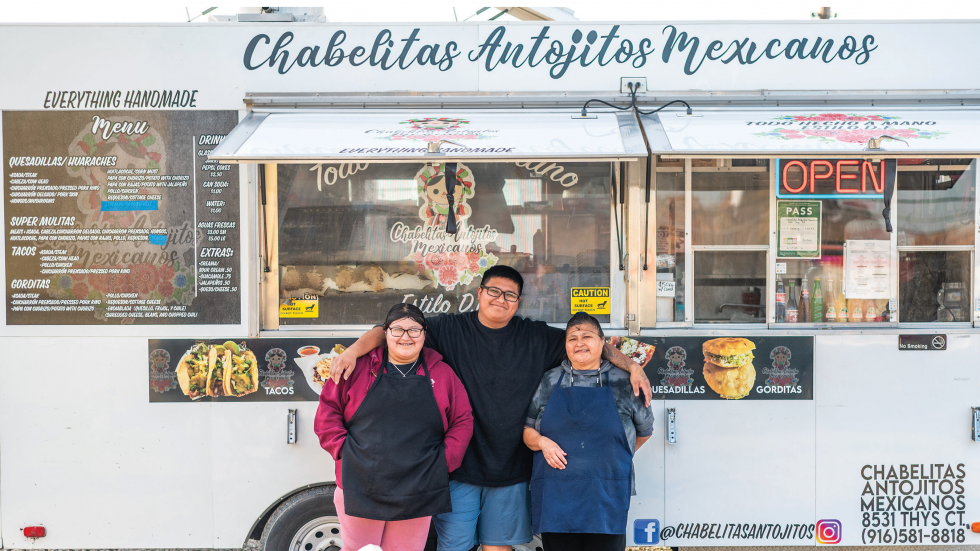
Hernandez started Chabelita’s with her mother and main chef, Isabel (nicknamed Chabelita), and her brother as a rudimentary food cart in September 2020. “A grill and an ice chest, carrying that around, is how we started. We started from the bottom,” Hernandez says with a chuckle.
The Instagram account was key to letting people know their location and still is today. The food truck, which they opened in December 2021, alternates between two locations on and near Northgate Boulevard.
Hernandez tries to post consistently throughout the day, mostly on Stories, including reposting when fans tag the account. Sometimes she’s too busy for more than one or two posts a day. Like Roberts of Pizza Supreme Being, she only uses TikTok to be able to add music to her posts and then reposts on Instagram. She often films discs of masa being deep-fried in golden fat for gorditas, or fresh tortillas taking shape hecho a mano (made by hand) for tacos.
What does she want to do if the account gets more social media followers? “If everything keeps going well, to open up another food truck,” Hernandez says. “Hopefully, it keeps growing.”
Stay up to date on business in the Capital Region: Subscribe to the Comstock’s newsletter today.
Recommended For You
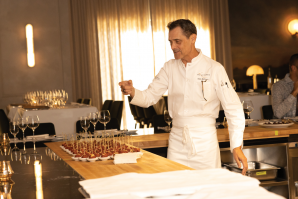
Star Power
The Michelin guide helps put Sacramento restaurants on the map
Winning a Michelin star is something ambitious chefs spend a lifetime dreaming of and working toward. A star from the world-famous Michelin Guide promises life-changing benefits: Money. Customers. Fame. There’s even a term for it: the Michelin effect.
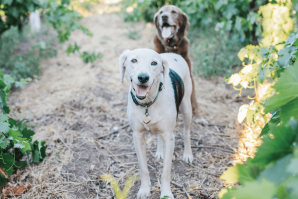
Going to the Dogs
Lodi vineyards and nurseries test canine pest detection
The solution to one of the wine industry’s most costly and threatening problems may be coming soon from Lodi — and it will trot out on four feet, tails a-wagging, with noses keener than even advanced scientific equipment.
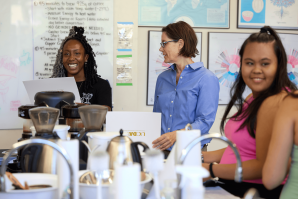
Brewed to Perfection
The most popular course at UC Davis teaches engineering students the scientific art of making coffee
Coffee is a $225 billion industry in the U.S., providing 1.6 million jobs. But are we growing, roasting and making the best cup possible? That’s what an innovative program at the UC Davis School of Chemical Engineering has been working on for the past 10 years.
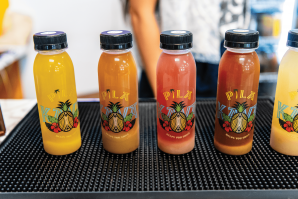
The Kava Capital
Sacramento has a thriving kava scene. Will newcomer Pila Kava offer something new?
The first sip of Pila Kava hits like a low dose of novocaine, numbness spreading across the surface of the tongue. This soon fades into a background hum as the flavors bloom. The first note is the earth and spice of the kava itself — the root of a pepper variety native to the South Pacific.
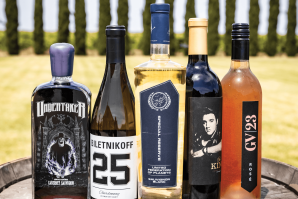
From Stargazing to Star-Sipping
How a Lodi family winery bottles the entertainment industry
Some moments in pop culture deserve a toast, such as when Season 3 of “Star Trek: Picard” sent critics and “Trekkies” on a warp-speed ride of jubilation, most hailing it the franchise’s best story in decades. Thanks to a small winery in Lodi, enthusiasts who were on that galactic high could pour their pleasure right into a glass.



